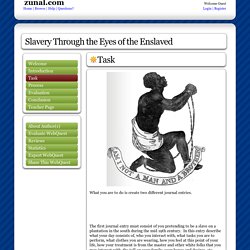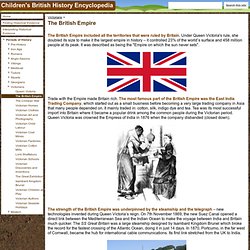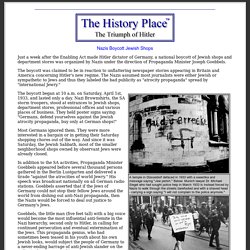

History: The Saxons & The Vikings. The Triangular Trade: created with Zunal WebQuest Maker. Slavery Through the Eyes of the Enslaved: created with Zunal WebQuest Maker. What you are to do is create two different journal entries.

The first journal entry must consist of you pretending to be a slave on a plantation in the south during the mid 19th century. In this entry describe what your day consists of, who you interact with, what tasks you are to perform, what clothes you are wearing, how you feel at this point of your life, how your treatment is from the master and other white folks that you may interact with, the toll on your family, your hopes and desires, etc.
The second journal entry must consist of the first person writing style of a former slave into a liberated free man. A source that you can use to formulate this journal entry is The Narrative of Frederick Douglas. In this entry focus your reflection on the differences of your life now compared to your enslavement. British Empire. The British Empire, which in the early decades of the 20th century covered nearly 30 million square kilometers with a population of 400-500 million people (roughly a quarter of the world's population), was the most extensive area under a single country's rule in history.

The Empire had come about through a succession of phases of expansion by trade, settlement[?] Or conquest, interspersed with intervals of pacific commercial and diplomatic activity or contraction over 400 years. The territories under British influence were scattered across every continent and every ocean; it was said with some truth that "the sun never sets on the British Empire". Territories that have been under the control of the British Empire. Background: English Colonialism England initially supported William the Conqueror's (c. 1029-1087) holdings in France. Colonization of the Americas England's American empire was slowly expanded by war and colonization. The British Empire - Children's British History Encyclopedia. The British Empire included all the territories that were ruled by Britain.

Under Queen Victoria's rule, she doubled its size to make it the largest empire in history – it controlled 23% of the world’s surface and 458 million people at its peak. It was described as being the "Empire on which the sun never sets". Trade with the Empire made Britain rich. The most famous part of the British Empire was the East India Trading Company, which started out as a small business before becoming a very large trading company in Asia that many people depended on. It mainly traded in: cotton, silk, indigo dye and tea. Smarthistory: a multimedia web-book about art and art history. Video. Adolf Hitler. Adolf Hitler was born on 20th April, 1889, in the small Austrian town of Braunau near the German border.

Both Hitler's parents had come from poor peasant families. His father Alois Hitler, the illegitimate son of a housemaid, was an intelligent and ambitious man and was at the time of Hitler's birth, a senior customs official in Lower Austria. Alois had been married before. In 1873 he had married Anna Glasl, the fifty-year-old adopted daughter of another customs collector. According to Ian Kershaw, the author of Hitler 1889-1936 (1998): "It is unlikely to have been a love-match. Klara Polzl, Hitler's mother, left home at sixteen to to join the household of her second cousin, Alois Hitler. Franziska saw Klara as a potential rival and insisted that she left the household. Triumph of Hitler: Nazis Boycott Jewish Shops. Just a week after the Enabling Act made Hitler dictator of Germany, a national boycott of Jewish shops and department stores was organized by Nazis under the direction of Propaganda Minister Joseph Goebbels.

The boycott was claimed to be in reaction to unflattering newspaper stories appearing in Britain and America concerning Hitler's new regime. The Nazis assumed most journalists were either Jewish or sympathetic to Jews and thus they labeled the bad publicity as "atrocity propaganda" spread by "international Jewry. " The boycott began at 10 a.m. on Saturday, April 1st, 1933, and lasted only a day. Nazi Brownshirts, the SA storm troopers, stood at entrances to Jewish shops, department stores, professional offices and various places of business. They held poster signs saying: "Germans, defend yourselves against the Jewish atrocity propaganda, buy only at German shops! " Activehistory.co. History.
Slavery in America. Slavery in America Slavery in America began in 1607 and continued until 1865.

These links tell you more about this controversial but, for a long time, legal practice. Slavery It's hard to imagine that people did these things to each other, but different times allowed different ideals. Your About Guide to African-American History reveals the terrible tragedy of slavery. Foes of Slavery These African-Americans are famous for fighting against slavery. Remembering Slavery: Those Who Survived Tell Their Stories Read about slavery in the words of the people who lived it and lived to tell about it. Black Resistance: Slavery in the U.S.
Thomas Paine Speaks Out Against Slavery This article was published in newspapers in 1775. The Underground Railroad Links, articles, pictures, stories, primary sources, and much more about this "route to freedom" followed by a great many slaves. History For Kids - By KidsPast.com. History For Kids.